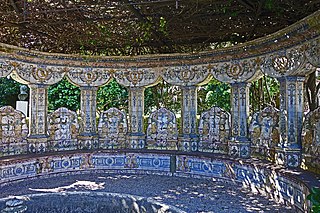Feteira is a rural civil parish in the municipality of Angra do Heroísmo in the Portuguese archipelago of the Azores. The population in 2011 was 1,239, in an area of 5.25 square kilometres (2.03 sq mi).

Vila Franca do Campo is a town and municipality in the southern part of the island of São Miguel in the Portuguese Autonomous Region of the Azores. The population of the municipality was 11,229 in 2011, in an area of 77.97 km². The town proper, which incorporates the urbanized parishes São Miguel and São Pedro, has 4100 inhabitants.

Ponta Garça is a civil parish in the municipality of Vila Franca do Campo in the Portuguese archipelago of the Azores. The population in 2011 was 3,547, in an area of 29.35 km2. It is the largest parish in Vila Franca do Campo.

Povoação is a municipality located in the southeastern corner of the island of São Miguel in the Portuguese archipelago of the Azores. The population in 2011 was 6,327, in an area of 106.41 km2.

Belém is a freguesia and district of Lisbon, the capital of Portugal. Belém is located in western Lisbon, to the west of Ajuda and Alcântara and directly east of Lisbon's border with Oeiras. Belém is famous as a museum district, as the home of many of the most notable monuments of Lisbon and Portugal alike, such as the Belém Tower, the Jerónimos Monastery, the Padrão dos Descobrimentos, and Belém Palace. The population in 2011 was 16,528.

Alcântara is a freguesia and district of Lisbon, the capital of Portugal. Located in western Lisbon, Alcântara is to the east of Ajuda and Belém and west of Estrela and Campo de Ourique. Alcântara had a population in 2011 of 13,943.

Ajuda is a freguesia and district of Lisbon, the capital of Portugal. Ajuda is located in western Lisbon, northeast of Belém and west of Alcântara. The population in 2011 was 15,617.

Alvalade is a freguesia and typical quarter of Lisbon, the capital city of Portugal. Located in central Lisbon, Alvalade is south of Lumiar and Olivais, west of Marvila, east of São Domingos de Benfica, and north of Avenidas Novas and Areeiro. The population in 2021 was 33,309.

São Domingos de Benfica is a freguesia and district of Lisbon, the capital of Portugal. Located in northern Lisbon, São Domingos de Benfica is east of Benfica, south of Carnide, west of Alvalade, and north of Campolide. The population in 2011 was 33,043,

Lumiar is a freguesia and typical quarter of Lisbon, the capital city of Portugal. Located in northern Lisbon, Lumiar is east of Carnide, north of Alvalade, west of Olivais, and south of Santa Clara and partially of Lisbon's border with Odivelas. The population in 2021 was 46,334.

Carnide is a freguesia and typical quarter of Lisbon, the capital city of Portugal. Located in northern Lisbon, Carnide is north of São Domingos de Benfica and Benfica, east of Lumiar, and directly south of Lisbon's border with Odivelas. The population in 2021 was 18,028.

Pena is a former parish (freguesia) in the municipality of Lisbon, Portugal. At the administrative reorganization of Lisbon on 8 December 2012 it became part of the parish Arroios. In 2001, the population of the district included 6038 residents, in an area of 0.5 km2, representing a highly compact population.

Castelo Branco is an inland city and municipality in Central Portugal. It has 34,455 inhabitants in its urban area (2021) and is the seat of the district of the same name. The municipality, with 52,272 inhabitants, is made up of 19 freguesias spread through 1,438.19 km2 (555.29 sq mi), making it the 3rd largest in Portugal by total land area.
The following is a timeline of the history of the city of Lisbon, Portugal.

Campo Grande is an elevated interchange station on the Yellow and Green Lines of the Lisbon Metro. It has a large bus terminal at ground level and is located on Rua Cipriano Dourado just north of Avenida General Norton de Matos in the Lisbon parish of Alvalade, in the neighbourhood of Campo Grande.

Santa Clara is a freguesia and typical quarter of Lisbon, the capital city of Portugal. Located in northern Lisbon, Santa Clara is north of Lumiar, west of Olivais, and directly south of Lisbon's border with Odivelas and Loures. The population in 2021 was 23,645.

São Vicente is a freguesia and district of Lisbon, the capital of Portugal. Located in the historic center of Lisbon, São Vicente is to the east of Santa Maria Maior, south of Arroios, and west of Penha de França. São Vicente is home to numerous historic neighborhoods, including Alfama. The population in 2021 was 13,956, for a population density of 7,013.1 inhabitants per km2 on an area of 1.99 square kilometers

The Blue Line or Seagull Line is one of the four lines of Lisbon Metro. It is the only line of the Lisbon Metro entirely underground, without any viaduct.

The Green Line or Caravel Line is one of the four lines of Lisbon Metro.

José Alfredo Holtreman Roquette, known as José Alvalade, was one of the founders and first club member of multisport club Sporting Clube de Portugal in the early twentieth century, along with brothers Stromp, Henrique de Almeida Leite Junior and the Gavazzo brothers. His grandfather, Alfredo Augusto das Neves Holtreman, Viscount of Alvalade, a lawyer in the Portuguese capital, operated as a benefactor in the multisport club's foundation process by donating money and land to the new club, and took charge as its first president. Later, José Alvalade would become Sporting's 3rd president from 1910 to 1912.



















